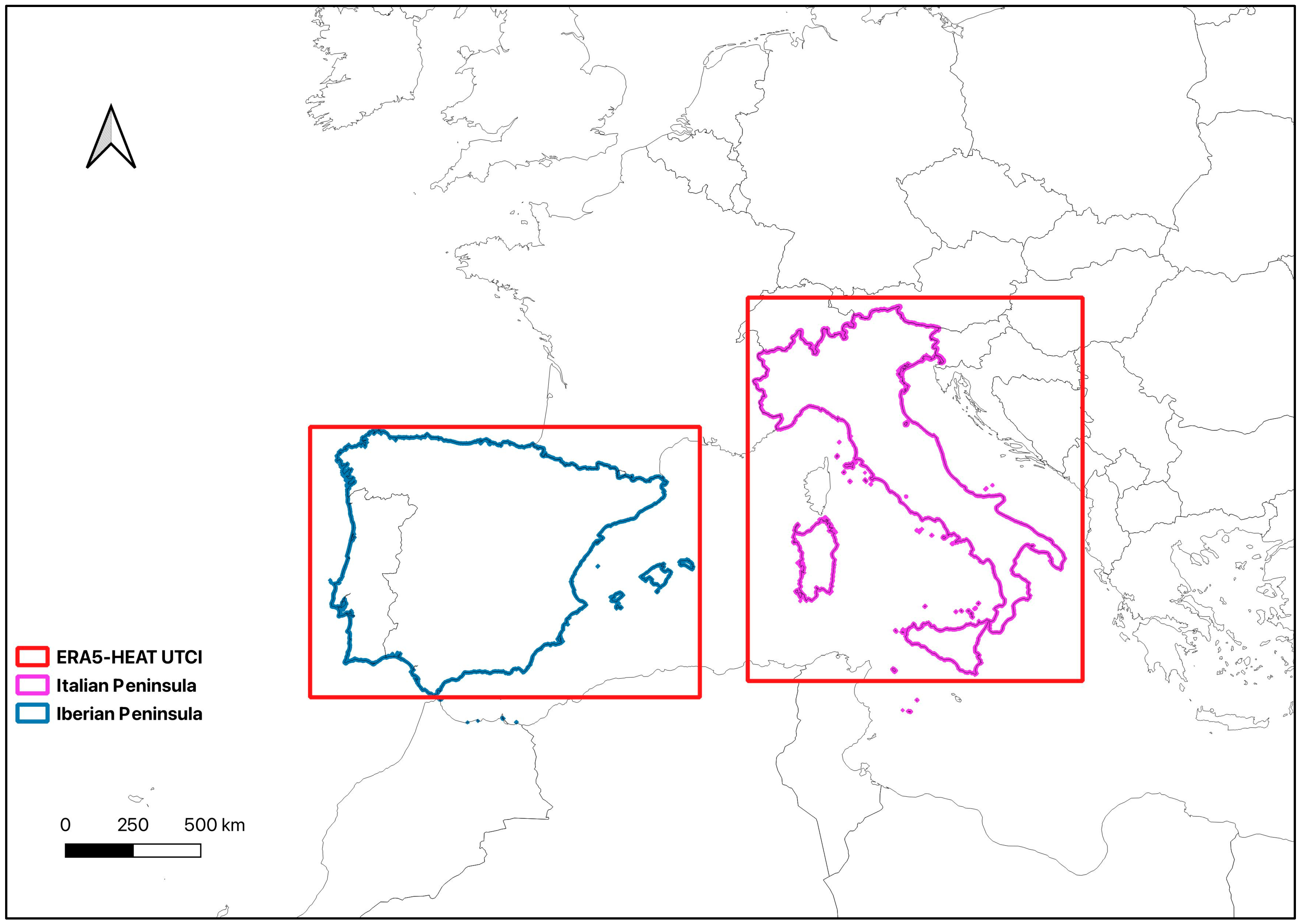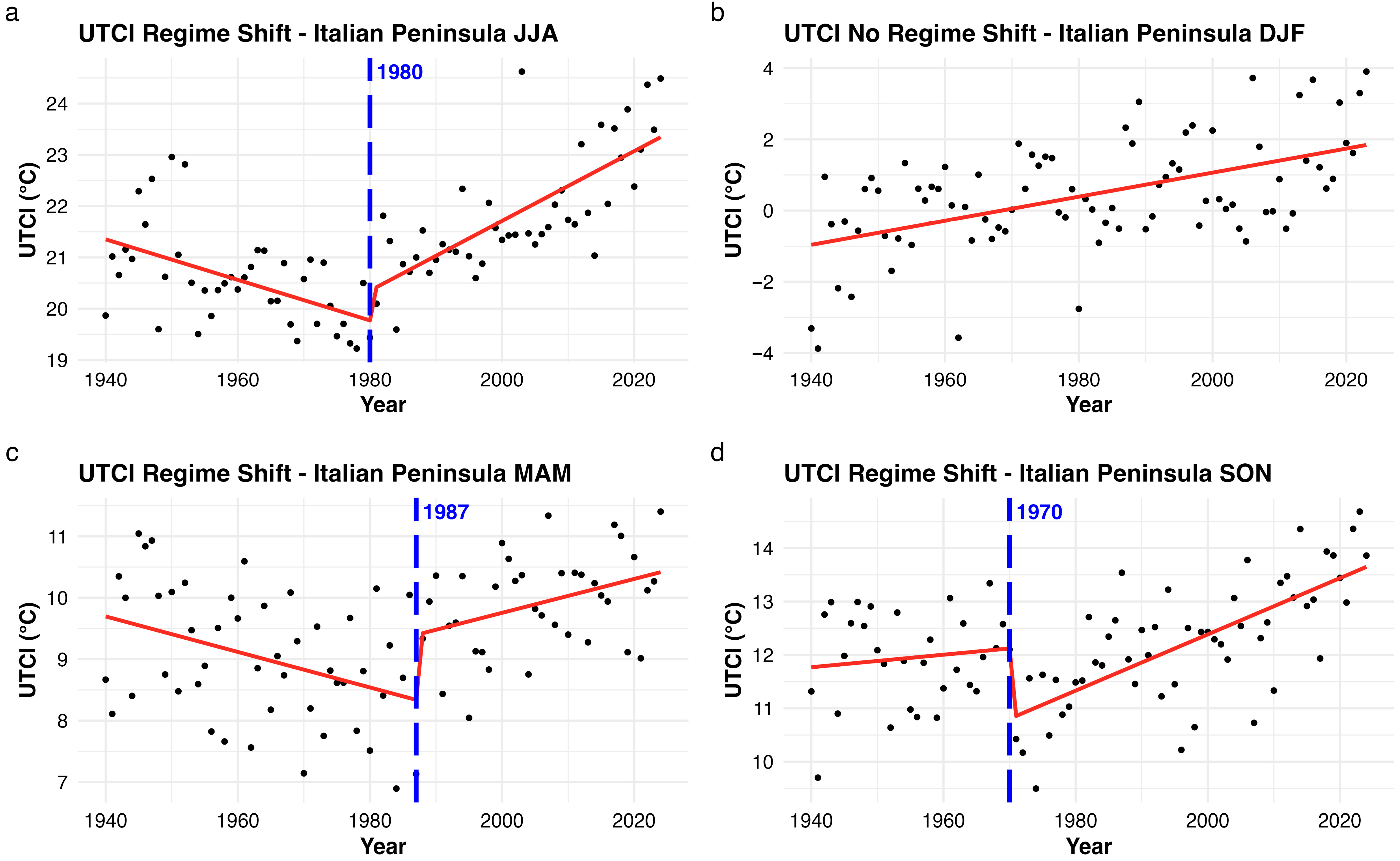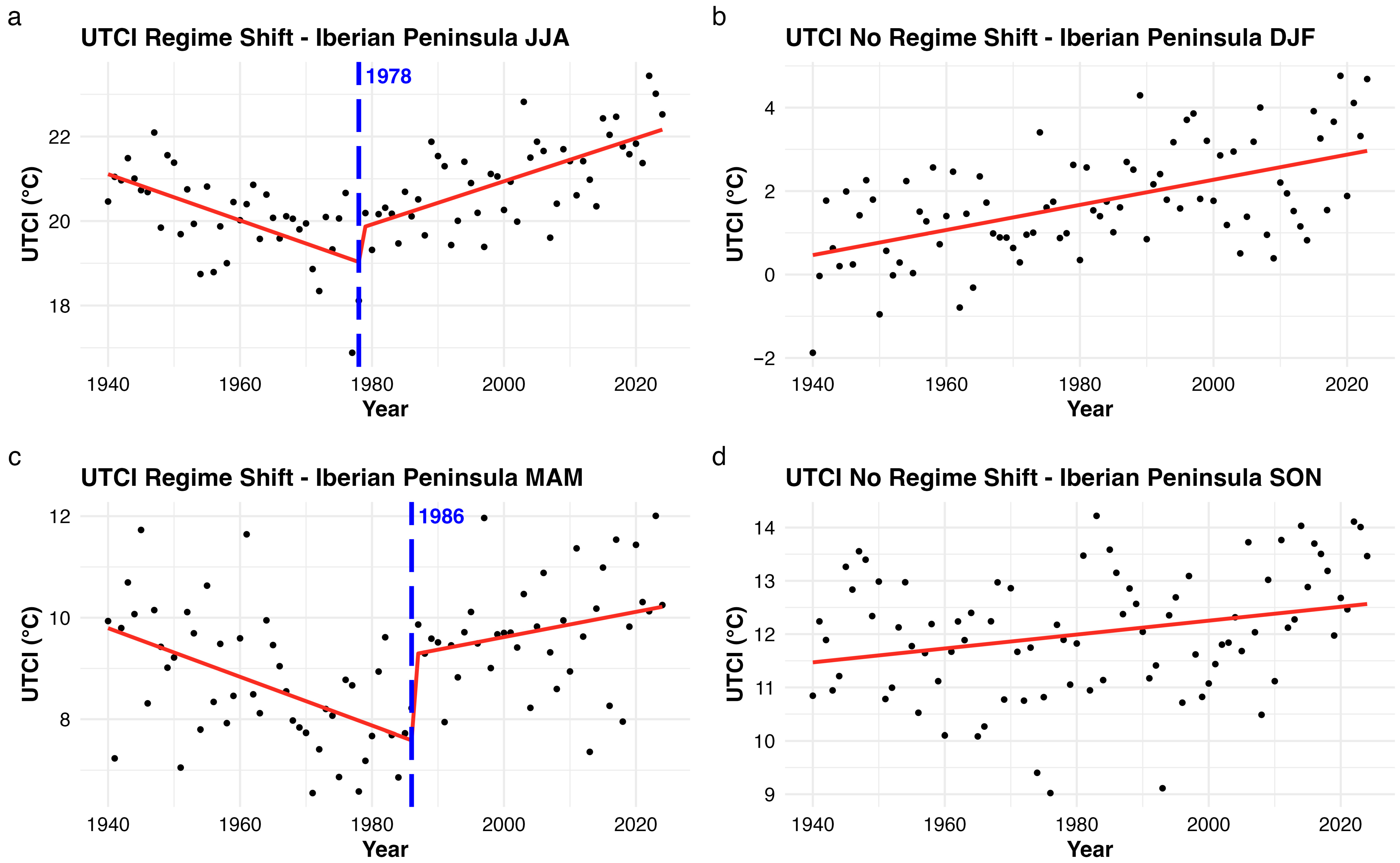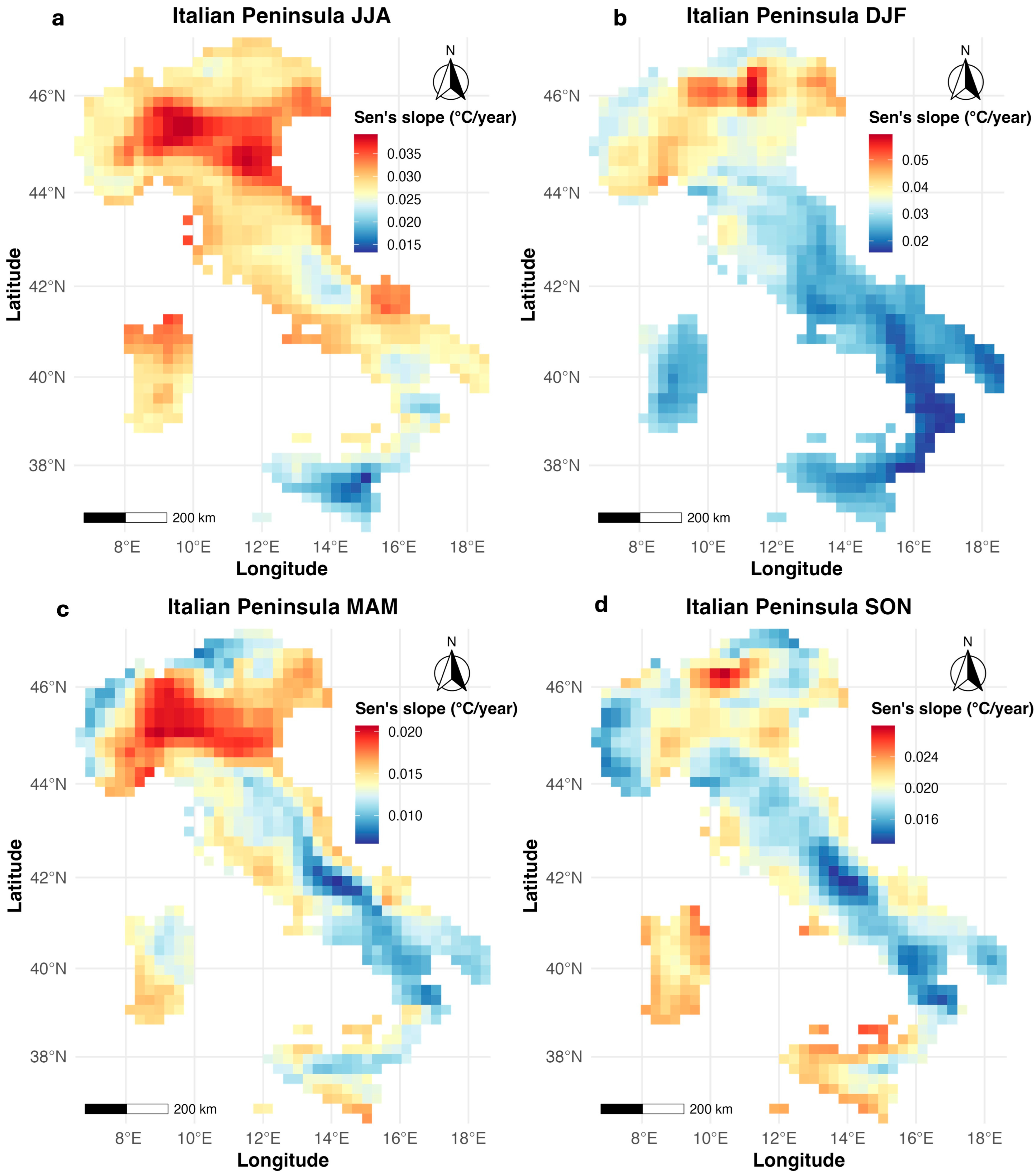Seasonal Regime Shifts and Warming Trends in the Universal Thermal Climate Index over the Italian and Iberian Peninsulas (1940–2024)
Abstract
1. Introduction
2. Materials and Methods
3. Results
3.1. Detection of Regime Shifts
3.2. Analysis of Trends
4. Discussion
4.1. Regime Shifts Reflect Threshold Dynamics
4.2. Gradual Winter Warming
4.3. Asymmetric Seasonal Dynamics
4.4. Spring: Early Warming Signals and Spatial Heterogeneity
4.5. Autumn: Consolidation of Summer Heat
4.6. Relevance for Policy and Adaptation
5. Conclusions
Supplementary Materials
Author Contributions
Funding
Data Availability Statement
Conflicts of Interest
References
- Paz, S. Impacts of climate change on Public Health of the Mediterranean population. Eur. J. Public Health 2020, 30 (Suppl. 5), ckaa165.512. [Google Scholar] [CrossRef]
- Tong, S.; Prior, J.; McGregor, G.; Shi, X.; Kinney, P. Urban heat: An increasing threat to global health. BMJ 2021, 375, n2467. [Google Scholar] [CrossRef]
- Hochman, A.; Marra, F.; Messori, G.; Pinto, J.G.; Raveh-Rubin, S.; Yosef, Y.; Zittis, G. Extreme weather and societal impacts in the eastern Mediterranean. Earth Syst. Dyn. 2022, 13, 749–777. [Google Scholar] [CrossRef]
- Li, J.; Chen, Y.D.; Gan, T.Y.; Lau, N.-C. Elevated increases in human-perceived temperature under climate warming. Nat. Clim. Change 2018, 8, 43–47. [Google Scholar] [CrossRef]
- Matzarakis, A.; Amelung, B. Physiological Equivalent Temperature as Indicator for Impacts of Climate Change on Thermal Comfort of Humans. In Seasonal Forecasts, Climatic Change and Human Health; Springer: Dordrecht, The Netherlands, 2008; pp. 161–172. [Google Scholar] [CrossRef]
- Fiala, D.; Lomas, K.J.; Stohrer, M. A computer model of human thermoregulation for a wide range of environmental conditions: The passive system. J. Appl. Physiol. 1999, 87, 1957–1972. [Google Scholar] [CrossRef] [PubMed]
- Fiala, D.; Havenith, G.; Bröde, P.; Kampmann, B.; Jendritzky, G. UTCI-Fiala multi-node model of human heat transfer and temperature regulation. Int. J. Biometeorol. 2011, 56, 429–441. [Google Scholar] [CrossRef] [PubMed]
- Bröde, P.; Fiala, D.; Błażejczyk, K.; Holmér, I.; Jendritzky, G.; Kampmann, B.; Tinz, B.; Havenith, G. Deriving the operational procedure for the Universal Thermal Climate Index (UTCI). Int. J. Biometeorol. 2011, 56, 481–494. [Google Scholar] [CrossRef]
- Błażejczyk, K.; Jendritzky, G.; Bröde, P.; Fiala, D.; Havenith, G.; Epstein, Y.; Psikuta, A.; Kampmann, B.; Tinz, B. An introduction to the Universal Thermal Climate Index (UTCI). Geogr. Pol. 2013, 86, 5–10. [Google Scholar] [CrossRef]
- Blazejczyk, K.; Epstein, Y.; Jendritzky, G.; Staiger, H.; Tinz, B. Comparison of UTCI to selected thermal indices. Int. J. Biometeorol. 2011, 56, 515–535. [Google Scholar] [CrossRef]
- Jendritzky, G.; de Dear, R.; Havenith, G. UTCI—Why another thermal index? Int. J. Biometeorol. 2011, 56, 421–428. [Google Scholar] [CrossRef]
- Błażejczyk, K.; Błażejczyk, A. Mapping the Universal Thermal Climate Index (In Different Scales). In Applications of the Universal Thermal Climate Index UTCI in Biometeorology; Springer: Cham, Germany, 2021; pp. 155–176. [Google Scholar] [CrossRef]
- Geletič, J.; Lehnert, M.; Resler, J.; Krč, P. Application of the UTCI in High-Resolution Urban Climate Modeling Techniques. In Applications of the Universal Thermal Climate Index UTCI in Biometeorology; Springer: Cham, Germany, 2021; pp. 177–191. [Google Scholar] [CrossRef]
- Krüger, E.L. Literature Review on UTCI Applications. In Applications of the Universal Thermal Climate Index UTCI in Biometeorology; Springer: Cham, Germany, 2021; pp. 23–65. [Google Scholar] [CrossRef]
- Ullah, S.; Aldossary, A.; Ullah, W.; Al-Ghamdi, S.G. Augmented human thermal discomfort in urban centers of the Arabian Peninsula. Sci. Rep. 2024, 14, 3974. [Google Scholar] [CrossRef]
- Kyaw, A.K.; Hamed, M.M.; Shahid, S. Spatiotemporal Changes in Universal Thermal Climate Index Over South Asia. Atmos. Res. 2023, 292, 106838. [Google Scholar] [CrossRef]
- Hamed, M.M.; Kyaw, A.K.; Nashwan, M.S.; Shahid, S. Spatiotemporal changes in Universal Thermal Climate Index in the Middle East and North Africa. Atmos. Res. 2023, 295, 107008. [Google Scholar] [CrossRef]
- Nam, C.; Lierhammer, L.; Buntemeyer, L.; Evadzi, P.; Cabana, D.; Celliers, L. Changes in universal thermal climate index from regional climate model projections over European beaches. Clim. Serv. 2024, 34, 100447. [Google Scholar] [CrossRef]
- Ahmadi, H.; Baaghideh, M. Investigating the potential effects of climate change on deviation of thermal and human bioclimatic conditions in Iran. Model. Earth Syst. Environ. 2019, 6, 439–453. [Google Scholar] [CrossRef]
- Wu, J.; Gao, X.; Giorgi, F.; Chen, D. Changes of effective temperature and cold/hot days in late decades over China based on a high resolution gridded observation dataset. Int. J. Climatol. 2017, 37, 788–800. [Google Scholar] [CrossRef]
- Zhu, J.; Wang, S.; Huang, G. Assessing Climate Change Impacts on Human-Perceived Temperature Extremes and Underlying Uncertainties. J. Geophys. Res. Atmos. 2019, 124, 3800–3821. [Google Scholar] [CrossRef]
- Isinkaralar, O.; Isinkaralar, K.; Sevik, H.; Küçük, Ö. Thermal comfort modeling, aspects of land use in urban planning and spatial exposition under future climate parameters. Int. J. Environ. Sci. Technol. 2025, 22, 11977–11990. [Google Scholar] [CrossRef]
- Pantavou, K.; Kotroni, V.; Kyros, G.; Lagouvardos, K. Thermal bioclimate in Greece based on the Universal Thermal Climate Index (UTCI) and insights into 2021 and 2023 heatwaves. Theor. Appl. Climatol. 2024, 155, 6661–6675. [Google Scholar] [CrossRef]
- Pantavou, K.; Kotroni, V.; Lagouvardos, K.; Kyriakou, P. Future changes of bioclimate in Greece: Variations in thermal stress according to the Universal Thermal Climate Index (UTCI). Sci. Total Environ. 2025, 980, 179514. [Google Scholar] [CrossRef]
- Hynčica, M.; Novák, M.; Procházková, S. Trends and Climatology of UTCI in the Czech Republic. Environ. Sci. Proc. 2023, 26, 31. [Google Scholar] [CrossRef]
- Shevchenko, O.; Snizhko, S.; Matzarakis, A. Recent trends on human thermal bioclimate conditions in Kyiv, Ukraine. Geogr. Pol. 2020, 93, 89–106. [Google Scholar] [CrossRef]
- Shevchenko, O. Human Thermal Comfort Conditions during Heat Wave Events in Kyiv, Ukraine. Environ. Res. Eng. Manag. 2021, 77, 99–109. [Google Scholar] [CrossRef]
- Alexander, L.V.; Zhang, X.; Peterson, T.C.; Caesar, J.; Gleason, B.; Klein Tank, A.; Haylock, M.; Collins, D.; Trewin, B.; Rahimzadeh, F.; et al. Global observed changes in daily climate extremes of temperature and precipitation. J. Geophys. Res. 2006, 111, D05109. [Google Scholar] [CrossRef]
- Donat, M.G.; Alexander, L.V.; Yang, H.; Durre, I.; Vose, R.; Dunn, R.J.H.; Willett, K.M.; Aguilar, E.; Brunet, M.; Caesar, J.; et al. Updated analyses of temperature and precipitation extreme indices since the beginning of the twentieth century: The HadEX2 dataset. J. Geophys. Res. Atmos. 2013, 118, 2098–2118. [Google Scholar] [CrossRef]
- Twardosz, R.; Walanus, A.; Guzik, I. Warming in Europe: Recent Trends in Annual and Seasonal temperatures. Pure Appl. Geophys. 2021, 178, 4021–4032. [Google Scholar] [CrossRef]
- Lenton, T.M.; Held, H.; Kriegler, E.; Hall, J.W.; Lucht, W.; Rahmstorf, S.; Schellnhuber, H.J. Tipping elements in the Earth’s climate system. Proc. Natl. Acad. Sci. USA 2008, 105, 1786–1793. [Google Scholar] [CrossRef]
- Lohmann, J.; Castellana, D.; Ditlevsen, P.D.; Dijkstra, H.A. Abrupt climate change as a rate-dependent cascading tipping point. Earth Syst. Dyn. 2021, 12, 819–835. [Google Scholar] [CrossRef]
- Armstrong McKay, D.I.; Staal, A.; Abrams, J.F.; Winkelmann, R.; Sakschewski, B.; Loriani, S.; Fetzer, I.; Cornell, S.E.; Rockström, J.; Lenton, T.M. Exceeding 1.5 °C global warming could trigger multiple climate tipping points. Science 2022, 377, eabn7950. [Google Scholar] [CrossRef] [PubMed]
- Cooper, G.S.; Willcock, S.; Dearing, J.A. Regime shifts occur disproportionately faster in larger ecosystems. Nat. Commun. 2020, 11, 1175. [Google Scholar] [CrossRef]
- Sardanyés, J.; Ivančić, F.; Vidiella, B. Identifying regime shifts, transients and late warning signals for proactive ecosystem management. Biol. Conserv. 2024, 290, 110433. [Google Scholar] [CrossRef]
- Di Napoli, C.; Barnard, C.; Prudhomme, C.; Cloke, H.L.; Pappenberger, F. ERA5-HEAT: A global gridded historical dataset of human thermal comfort indices from climate reanalysis. Geosci. Data J. 2020, 8, 2–10. [Google Scholar] [CrossRef]
- Gorelick, N.; Hancher, M.; Dixon, M.; Ilyushchenko, S.; Thau, D.; Moore, R. Google Earth Engine: Planetary-scale geospatial analysis for everyone. Remote Sens. Environ. 2017, 202, 18–27. [Google Scholar] [CrossRef]
- QGIS Development Team. QGIS Version 3.34. Geographic Information System. Open-Source Geospatial Foundation Project. 2024. Available online: https://www.qgis.org/en/site/ (accessed on 10 June 2025).
- R Core Team. R: A Language and Environment for Statistical Computing; R Foundation for Statistical Computing: Vienna, Austria, 2023; Available online: https://www.R-project.org/ (accessed on 10 June 2025).
- Zeileis, A.; Kleiber, C.; Krämer, W.; Hornik, K. Testing and dating of structural changes in practice. Comput. Stat. Data Anal. 2003, 44, 109–123. [Google Scholar] [CrossRef]
- Sen, P.K. Estimates of the Regression Coefficient Based on Kendall’s Tau. J. Am. Stat. Assoc. 1968, 63, 1379. [Google Scholar] [CrossRef]
- Mann, H.B. Nonparametric Tests Against Trend. Econometrica 1945, 13, 245–259. [Google Scholar] [CrossRef]
- McLeod, A. Kendall: Kendall Rank Correlation and Mann-Kendall Trend Test. R Package Version 2.2.1. 2022. Available online: https://CRAN.R-project.org/package=Kendall (accessed on 13 June 2025).
- Stefanon, M.; D’Andrea, F.; Drobinski, P. Heatwave classification over Europe and the Mediterranean region. Environ. Res. Lett. 2012, 7, 014023. [Google Scholar] [CrossRef]
- Qasmi, S.; Sanchez-Gomez, E.; Ruprich-Robert, Y.; Boé, J.; Cassou, C. Modulation of the Occurrence of Heatwaves over the Euro-Mediterranean Region by the Intensity of the Atlantic Multidecadal Variability. J. Clim. 2021, 34, 1099–1114. [Google Scholar] [CrossRef]
- Lu, J.; Vecchi, G.A.; Reichler, T. Expansion of the Hadley cell under global warming. Geophys. Res. Lett. 2007, 34. [Google Scholar] [CrossRef] [PubMed]
- Hirschi, M.; Seneviratne, S.I.; Alexandrov, V.; Boberg, F.; Boroneant, C.; Christensen, O.B.; Formayer, H.; Orlowsky, B.; Stepanek, P. Observational evidence for soil-moisture impact on hot extremes in southeastern Europe. Nat. Geosci. 2010, 4, 17–21. [Google Scholar] [CrossRef]
- Materia, S.; Ardilouze, C.; Prodhomme, C.; Donat, M.G.; Benassi, M.; Doblas-Reyes, F.J.; Peano, D.; Caron, L.-P.; Ruggieri, P.; Gualdi, S. Summer temperature response to extreme soil water conditions in the Mediterranean transitional climate regime. Clim. Dyn. 2021, 58, 1943–1963. [Google Scholar] [CrossRef]
- Collie, J.S.; Richardson, K.; Steele, J.H. Regime shifts: Can ecological theory illuminate the mechanisms? Prog. Oceanogr. 2004, 60, 281–302. [Google Scholar] [CrossRef]
- Conversi, A.; Fonda Umani, S.; Peluso, T.; Molinero, J.C.; Santojanni, A.; Edwards, M. The Mediterranean Sea Regime Shift at the End of the 1980s, and Intriguing Parallelisms with Other European Basins. PLoS ONE 2010, 5, e10633. [Google Scholar] [CrossRef]
- Christidis, N.; Stott, P.A.; Zwiers, F.W.; Shiogama, H.; Nozawa, T. The contribution of anthropogenic forcings to regional changes in temperature during the last decade. Clim. Dyn. 2011, 39, 1259–1274. [Google Scholar] [CrossRef]
- Estrada, F.; Kim, D.; Perron, P. Anthropogenic influence in observed regional warming trends and the implied social time of emergence. Commun. Earth Environ. 2021, 2, 31. [Google Scholar] [CrossRef]
- Deser, C.; Phillips, A.S. A range of outcomes: The combined effects of internal variability and anthropogenic forcing on regional climate trends over Europe. Nonlinear Process. Geophys. 2023, 30, 63–84. [Google Scholar] [CrossRef]
- Zhang, P.; Ren, G.; Xu, Y.; Wang, X.L.; Qin, Y.; Sun, X.; Ren, Y. Observed Changes in Extreme Temperature over the Global Land Based on a Newly Developed Station Daily Dataset. Am. Meteorol. Soc. 2019, 32, 8489–8509. [Google Scholar] [CrossRef]
- Pastor, F.; Valiente, J.A.; Palau, J.L. Sea Surface Temperature in the Mediterranean: Trends and Spatial Patterns (1982–2016). In Meteorology and Climatology of the Mediterranean and Black Seas; Birkhäuser: Cham, Germany, 2019; pp. 297–309. [Google Scholar] [CrossRef]
- Bednorz, E.; Tomczyk, A.M.; Czernecki, B.; Piękny, M. Impact of regional-scale atmospheric circulation patterns on winter air temperature variability in the Svalbard area. Pol. Polar Res. 2023, 45, 21–42. [Google Scholar] [CrossRef]
- Hadjinicolaou, P.; Tzyrkalli, A.; Zittis, G.; Lelieveld, J. Urbanisation and Geographical Signatures in Observed Air Temperature Station Trends Over the Mediterranean and the Middle East–North Africa. Earth Syst. Environ. 2023, 7, 649–659. [Google Scholar] [CrossRef]
- Woolway, R.I.; Dokulil, M.T.; Marszelewski, W.; Schmid, M.; Bouffard, D.; Merchant, C.J. Warming of Central European lakes and their response to the 1980s climate regime shift. Clim. Change 2017, 142, 505–520. [Google Scholar] [CrossRef]
- Bathiany, S.; Scheffer, M.; van Nes, E.H.; Williamson, M.S.; Lenton, T.M. Abrupt Climate Change in an Oscillating World. Sci. Rep. 2018, 8, 5040. [Google Scholar] [CrossRef]
- Barcikowska, M.J.; Kapnick, S.B.; Krishnamurty, L.; Russo, S.; Cherchi, A.; Folland, C.K. Changes in the future summer Mediterranean climate: Contribution of teleconnections and local factors. Earth Syst. Dyn. 2020, 11, 161–181. [Google Scholar] [CrossRef]
- Francis, J.A.; Vavrus, S.J. Evidence linking Arctic amplification to extreme weather in mid-latitudes. Geophys. Res. Lett. 2012, 39. [Google Scholar] [CrossRef]
- Luedeling, E. Climate change impacts on winter chill for temperate fruit and nut production: A review. Sci. Hortic. 2012, 144, 218–229. [Google Scholar] [CrossRef]
- Fernandez, E.; Mojahid, H.; Fadón, E.; Rodrigo, J.; Ruiz, D.; Egea, J.A.; Ben Mimoun, M.; Kodad, O.; El Yaacoubi, A.; Ghrab, M.; et al. Climate change impacts on winter chill in Mediterranean temperate fruit orchards. Reg. Environ. Change 2022, 23. [Google Scholar] [CrossRef]
- Škvareninová, J.; Lukasová, V.; Borsányi, P.; Kvas, A.; Vido, J.; Štefková, J.; Škvarenina, J. The effect of climate change on spring frosts and flowering of Crataegus laevigata—The indicator of the validity of the weather lore about “The Ice Saints”. Ecol. Indic. 2022, 145, 109688. [Google Scholar] [CrossRef]
- Yuan, G.; Huang, W.; Zhao, Q.; Ryti, N.; Armstrong, B.; Gasparrini, A.; Tong, S.; Pascal, M.; Urban, A.; Zeka, A.; et al. Global, regional, and national burden of mortality associated with cold spells during 2000–19: A three-stage modelling study. Lancet Planet. Health 2024, 8, e108–e116. [Google Scholar] [CrossRef]
- Isaac, M.; van Vuuren, D.P. Modeling global residential sector energy demand for heating and air conditioning in the context of climate change. Energy Policy 2009, 37, 507–521. [Google Scholar] [CrossRef]
- Dirmeyer, P.A.; Cash, B.A.; Kinter, J.L.; Stan, C.; Jung, T.; Marx, L.; Towers, P.; Wedi, N.; Adams, J.M.; Altshuler, E.L.; et al. Evidence for Enhanced Land–Atmosphere Feedback in a Warming Climate. J. Hydrometeorol. 2012, 13, 981–995. [Google Scholar] [CrossRef]
- Zittis, G.; Hadjinicolaou, P.; Lelieveld, J. Land-Atmosphere Coupling: The Feedback of Soil Moisture into Surface Temperature in Eastern Mediterranean and Middle East. In Advances in Meteorology, Climatology and Atmospheric Physics; Springer: Berlin/Heidelberg, Germany, 2012; pp. 833–839. [Google Scholar] [CrossRef]
- Findell, K.L.; Yin, Z.; Seo, E.; Dirmeyer, P.A.; Arnold, N.P.; Chaney, N.; Fowler, M.D.; Huang, M.; Lawrence, D.M.; Ma, P.-L.; et al. Accurate assessment of land–atmosphere coupling in climate models requires high-frequency data output. Geosci. Model Dev. 2024, 17, 1869–1883. [Google Scholar] [CrossRef]





| UTCI Category | UTCI Range (°C) |
|---|---|
| Extreme Cold Stress | <−40 °C |
| Very Strong Cold Stress | −40 °C to −27 °C |
| Strong Cold Stress | −27 °C to −13 °C |
| Moderate Cold Stress | −13 °C to 0 °C |
| Slight Cold Stress | 0 °C to 9 °C |
| No Thermal Stress | 9 °C to 26 °C |
| Moderate Heat Stress | 26 °C to 32 °C |
| Strong Heat Stress | 32 °C to 38 °C |
| Very Strong Heat Stress | 38 °C to 46 °C |
| Extreme Heat Stress | >46 °C |
Disclaimer/Publisher’s Note: The statements, opinions and data contained in all publications are solely those of the individual author(s) and contributor(s) and not of MDPI and/or the editor(s). MDPI and/or the editor(s) disclaim responsibility for any injury to people or property resulting from any ideas, methods, instructions or products referred to in the content. |
© 2025 by the authors. Licensee MDPI, Basel, Switzerland. This article is an open access article distributed under the terms and conditions of the Creative Commons Attribution (CC BY) license (https://creativecommons.org/licenses/by/4.0/).
Share and Cite
Cotlier, G.I.; Jimenez, J.C. Seasonal Regime Shifts and Warming Trends in the Universal Thermal Climate Index over the Italian and Iberian Peninsulas (1940–2024). Climate 2025, 13, 184. https://doi.org/10.3390/cli13090184
Cotlier GI, Jimenez JC. Seasonal Regime Shifts and Warming Trends in the Universal Thermal Climate Index over the Italian and Iberian Peninsulas (1940–2024). Climate. 2025; 13(9):184. https://doi.org/10.3390/cli13090184
Chicago/Turabian StyleCotlier, Gabriel I., and Juan Carlos Jimenez. 2025. "Seasonal Regime Shifts and Warming Trends in the Universal Thermal Climate Index over the Italian and Iberian Peninsulas (1940–2024)" Climate 13, no. 9: 184. https://doi.org/10.3390/cli13090184
APA StyleCotlier, G. I., & Jimenez, J. C. (2025). Seasonal Regime Shifts and Warming Trends in the Universal Thermal Climate Index over the Italian and Iberian Peninsulas (1940–2024). Climate, 13(9), 184. https://doi.org/10.3390/cli13090184









